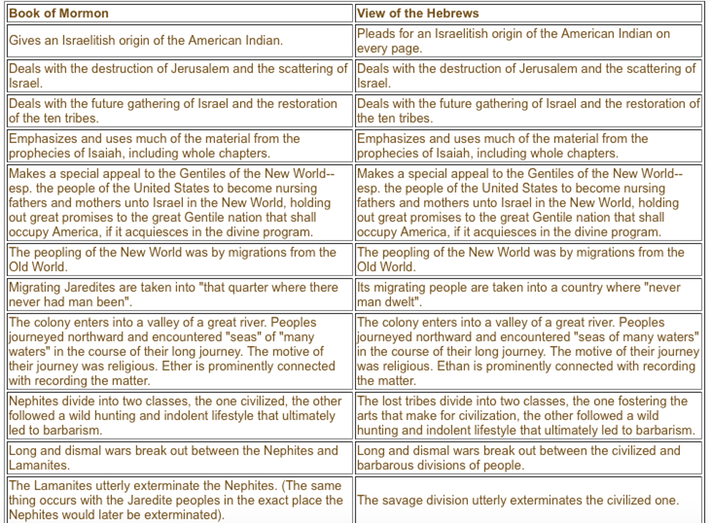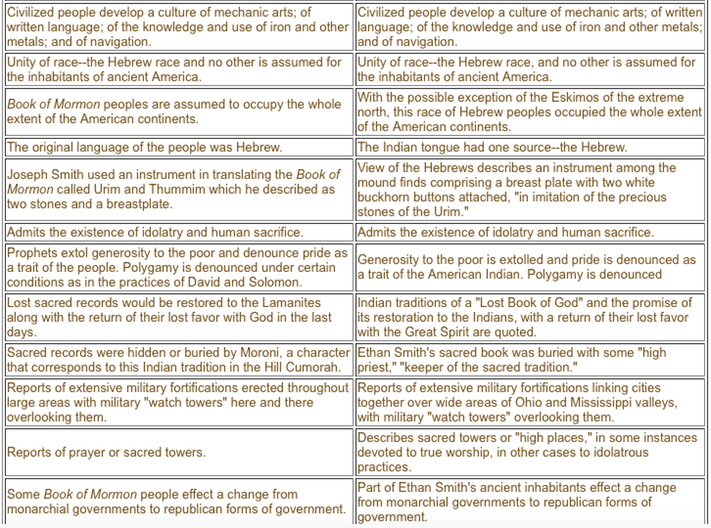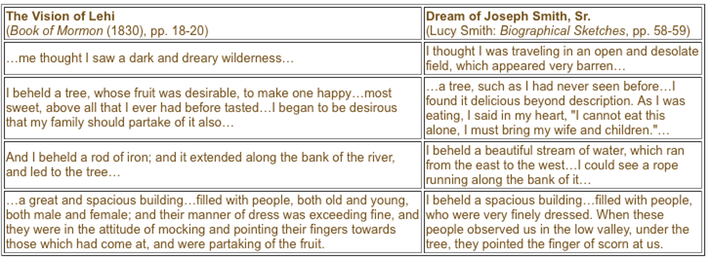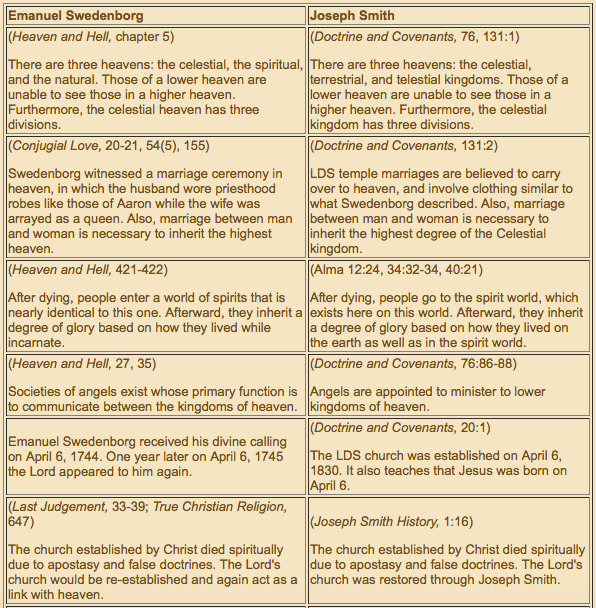Book of Mormon
Early Mormon Apostle Orson Pratt made a statement concerning the Book of Mormon:
"The Book of Mormon must be either true or false. If true, it is one of the most important messages ever sent from God…If false, it is one of the most cunning, wicked, bold, deep-laid impositions ever palmed upon the world, calculated to deceive and ruin millions…The nature of the "Book of Mormon" is such, that if true, no one can possibly be saved and reject it; If false, no one can possibly be saved and receive it…If, after a rigid examination, it be found imposition, it should be extensively published to the world as such; the evidences and arguments on which the imposture was detected, should be clearly and logically stated, that those who have been sincerely yet unfortunately deceived, may perceive the nature of deception, and to be reclaimed, and that those who continue to publish the delusion may be exposed and silenced…by strong and powerful arguments - by evidences adduced from scripture and reason…" (Orson Pratt's Works, Divine Authenticity of the Book of Mormon, Liverpool, 1851, pp. 1, 2.)
Joseph's mother recorded that long before Joseph had received the gold plates he was well aware of the stories contained therein:
"During our evening conversations, Joseph would occasionally give us some of the most amusing recitals that could be imagined. He would describe the ancient inhabitants of this continent, their dress, mode of traveling, and the animals upon which they rode; their cities, their buildings, with every particular; their mode of warfare; and also their religious worship. This he would do with as much ease, seemingly, as if he had spent his whole life with them." (Lucy Smith, Biographical Sketches, p. 85)
Joseph told these stories well before his brother Alvin's death in November, 1823. Yet he never got the plates until September, 1827. Where did all this specific information come from? We have no record of these kinds of details being given to Joseph through his annual interviews with Moroni. Where else but from Joseph's fertile imagination and the source materials to which he had access?
The Indian mounds that dotted western New York were a constant source of speculation during the time Joseph grew up there. It was a common legend that western New York and Ohio had once been the site of a terrible slaughter and that the mounds were the cemeteries of an entire race. In 1821, a Palmyra newspaper stated that diggers on the Erie Canal had unearthed "several brass plates" along with skeletons and fragments of pottery. (Fawn Brodie, No Man Knows My History, pp. 35-36)
That Native Americans descended from the Hebrews was a popular theory at the time Joseph lived. America's most distinguished preachers - William Penn, Roger Williams, Cotton Mather, Jonathan Edwards - had all espoused the theory. A Jewish rabbi, M. M. Noah, summarized the parallels between the cultures of Hebraic and Indian customs in Joseph's hometown paper on October 11, 1825. Joseph unquestionably had access to the Wayne Sentinel, for on August 11, 1826 his father was listed among the delinquent subscribers as owing $5.60. (Fawn Brodie, No Man Knows My History, 45-46)
Ethan Smith was a minister of a Congregational Church in Poultney, Vermont from 1821 to 1826 when he wrote View of the Hebrews. It was first published in 1823 (the Book of Mormon was published 6 years later in 1829). Interestingly, Oliver Cowdery, scribe, and later witness of the Book of Mormon, lived in Poultney for 22 years until 1825. Cowdery's stepmother and three of his sisters were members of Ethan Smith's congregation. No direct evidence exists that would prove or disprove Joseph Smith had read View of the Hebrews. Another book, The Wonders of Nature and Providence Displayed, was in the local Manchester Library (five miles from Joseph Smith's home) and extant records show that it was reportedly checked out during the years 1826 to 1828. This book includes a long selection from Ethan Smith's book and attempts to establish a Hebrew origin for Native Americans.
Ethan Smith's theory of the origin of the Indian mounds was exactly the same as that which formed the heart of the Book of Mormon story:
"Israel brought into this new continent a considerable degree of civilization; and the better part of them long laboured to maintain it. But others fell into the hunting and consequently savage state; whose barbarous hordes invaded their more civilized brethren, and eventually annihilated most of them, and all in these northern regions!" (View of the Hebrews, p. 184)
Ethan Smith also reported the legend, said to have come from an Indian chief, that they:
"…had not long since a book which they had for a long time preserved. But having lost the knowledge of reading it, they concluded it would be of no further use to them; and they buried it with an Indian chief." (View of the Hebrews, p. 223)
Perhaps this is where Joseph first got the idea to "find" the golden plates. That he knew about this legend was clear, for he quoted it in his church newspaper years later as evidence of the historical accuracy of the Book of Mormon. (Times and Seasons, Nauvoo, Illinois, Vol. 3 (June 1, 1842), pp. 813-814)
Consider the similarities between the Book of Mormon and View of the Hebrews as summarized by Elder B. H. Roberts:



Elder Roberts closes these parallels with this imposing question:
"Can such numerous and startling points of resemblance and suggestive contact be merely coincidence?" (B. H. Roberts, Studies of the Book of Mormon, (University of Illinois Press, 1985), p. 242)
Joseph borrowed liberally from the Bible in creating the Book of Mormon. Approximately 25,000 words in the Book of Mormon consist of passages from the Old Testament, mainly chapters from Isaiah that Ethan Smith mentioned in View of the Hebrews. Another 2,000 words were taken from the New Testament. (Fawn Brodie, No Man Knows My History, p. 58)
The original text of II Nephi 16:2 reads:
"Above it stood the seraphims: each one had six wings; with twain he covered his face, and with twain he covered his feet, and with twain he did fly."
This is a quotation from the King James Version of the Bible, specifically Isaiah 6:2. In a rare grammatical mistake, the KJV has an incorrect plural for 'seraph'. The correct plural should be "seraphim", as the later text of II Nephi 16:2 reads. How does one explain that Joseph would make the exact spelling error in the Book of Mormon "translation" that the writers of the KJV of the Bible made centuries before?
Joseph even appears to have plagiarized his father. For many years his mother cherished the details of several of her husband's dreams, and one of these was incorporated wholesale into the Book of Mormon as a vision by Lehi, the father of Nephi.

Bible
Joseph had no need to justify having ancient records in his translation of the Bible. He simply modified the King James version on the basis of raw revelation. This included modernizing many sentences as well as making occasional changes in doctrine. He even inserted in the Book of Genesis a prophecy of his own coming. Joseph, son of Jacob, was made to say:
"Thus saith the Lord God of my fathers unto me, A choice seer will I raise up out of the fruit of thy loins, and he shall be esteemed highly among the fruit of thy loins…and his name shall be called Joseph, and it shall be after the name of his father…" (JST Genesis 50:27, 33)
Joseph also elaborated significantly on the prophecy of Isaiah (chapter 29) concerning the learned man and the sealed book. He added numerous details which closely matched the event of Martin Harris visiting Charles Anthon for confirmation of the reformed Eygptian, in which the Book of Mormonwas claimed to be written. The prophecy of Isaiah was also made to include references to the Book of Mormon witnesses and the return of the golden plates to the Lord.
This went beyond plagiarism to the actual spinning of pre-existing scripture to support the divinity of Joseph's mission and the church he established.
Book of Abraham
As a result of the School of the Prophets established in March 1833, Joseph learned that Elohim, one of the Hebrew words for God, is plural. This likely provided the foundation for his claim in the Book of Abraham that "The Gods organized the earth." (Millennial Star, Vol. 3 (Liverpool, England, August 1842), p. 71).
Joseph also possessed a copy of Thomas Dick's Philosophy of a Future State (Vol. 1 & 2), a dissertation on astronomy and metaphysics. One can see many of Dick's ideas woven into the Book of Abraham; for example, the thesis that matter is eternal and indestructible, and the mathematics of the heavens - the innumerable stars and vast distances. Abraham relates that there is one star, Kolob, near the throne of God, and that one revolution of Kolob takes 1,000 years. The stars are inhabited by spirits that differ among themselves in quality of intelligence as the stars differ in magnitude. These concepts apparently came directly from Thomas Dick, who speculated that the stars are peopled by "various orders of intelligences," and that these intelligences were "progressive beings" in various stages of evolution toward perfection. Dick also speculated that "the systems of the universe revolve around a common centre…the throne of God." (see Philosophy of a Future State (Brookfield, Massachusetts, 2nd ed., 1830), pp. 101, 230, 241, 249; Fawn Brodie, No Man Knows My History, pp. 171-173; Marvin S. Hill, Quest for Refuge).
The Book of Abraham also discusses the origin of African-Americans, a major political and moral question at the time the book was published. As a youth, Joseph had read in his geography book the common tradition that all races of men are descended from the three sons of Noah: Ham, Shem, and Japheth (see Thomas T. Smiley: Sacred Geography (Philadelphia, 1824). The copy owned by Joseph Smith is currently in the library of the Reorganized Church in Independence, Missouri). Noah had cursed Ham, stating that Canaan, the son of Ham, should be a "servant of servants" unto his brethren. This story, which the Southern preachers of Joseph's day used to justify slavery, was apparently expanded by Joseph in the Book of Abraham. He claimed that Pharaoh, first ruler of Egypt, was the son of Egyptus, daughter of Ham. The Egyptians thus inherited Noah's curse of a black skin, including a denial to the right of the priesthood. This provided an avenue for Joseph to express his views on the question of slavery. Soon afterward he published a statement in his church newspaper attacking the abolitionist position as being:
"…calculated to lay waste the fair states of the South, and let loose upon the world a community of people, who might, peradventure, overrun our society, and violate the most sacred principles of human society, chastity and virtue… the first mention we have of slavery is found in the Holy Bible…and so far from that prediction being averse to the mind of God, it remains as a lasting monument of the decree of Jehovah, to the shame and confusion of all who have cried out against the South, in consequence of their holding the sons of Ham in servitude…I can say, the curse is not yet taken off from the sons of Canaan, neither will be until it is affected by as great a power as caused it to come…" (History of the Church, Vol. 2, pp. 436-438)
Emanuel Swedenborg
In 1784 a man by the name of Emanuel Swedenborg wrote about his visions of the afterlife. His teachings were remarkably similar to what Joseph Smith later claimed to receive as revelation. For example, Swedenborg taught: "There are three heavens," described as "entirely distinct from each other." He called the highest heaven "the Celestial Kingdom," and stated that the inhabitants of the three heavens corresponded to the "sun, moon and stars." This directly parallels Joseph's vision on the degrees of glory as recorded in Doctrine and Covenants 76.
By Joseph Smith's own statements, he was familiar with Swedenborg's writings. Joseph told a convert by the name of Edward Hunter that:
"Emanuel Swedenborg had a view of the world to come, but for daily food he perished." (Statement in 1839 by Joseph Smith to Edward Hunter, a Swedenborgian convert who later became the presiding bishop of the Church)
While Joseph clearly did not base all his theology on Swedenborg (there are several important differences), there are similarities to what Swedenborg wrote. The following table discusses some of these similarities:"Relating her family's history from memory in 1845, when Lucy Mack Smith came to the early visions of her son Joseph Smith, she (or her ghost writers, Howard and Martha Coray) simply quoted from the published version in the Times and Seasons. When Lucy related the first visionary experiences of her husband that had occurred in 1811 (34 years prior to the time that the 69-year-old woman sought to reconstruct her life's experiences), they appeared remarkably close to the dream related by Lehi in the Book of Mormon. The Tanners conclude that the original 1811 dream is the Item X that Joseph Smith copied into the Book of Mormon Lehi dream (Item Y). But the Tanners are confusing the elements of the textual parallel: the subject of comparison is the written description of the dreams, and if one insists on the post hoc ergo propter hoc analysis of similarities, then the Lucy Mack Smith version written in 1845 was the Item Y that was dependent on, copied from, derived from, the fifteen-year-earlier published dream in the Book of Mormon. (Item X). If one looks for an Item A, B, or C that was an antecedent for the Lehi dream in the Book of Mormon, the Tree of Life symbols and texts of the ancient world deserve a consideration which the Tanners will not give because they are already convinced that the Book of Mormon is not an ancient text…
"This ancient insistence upon repetitive patterns and archetypes is reflected in a distaste for "originality" that pervades written scripture. The Tanners have done a commendable job of showing the passages from the Book of Mormon that are virtual quotations or paraphrases of the Bible (pages 74-79), and had they wanted to they could have quoted from studies showing similar patternism in the revelations of the Doctrine and Covenants. Rather than discrediting these two books as legitimate works of scripture, that characteristic of apparent borrowing is completely consistent with biblical scripture. Large revelatory passages of Isaiah, Jeremiah, Ezekiel, Nahum, Obadiah, and Zephaniah are so similar as to appear to have been used interchangeably by their authors as they sought to reconstruct the "word of the Lord" to them. Moreover, many standard texts of the New Testament in Greek list the hundreds of quotations and paraphrases from the Old Testament and Apocrypha."

Joseph Smith was initiated as an entered apprentice Mason on March 15, 1842, and received the fellow craft and master degrees the following day. He introduced the full endowment ceremony which included the secret signs, tokens, passwords, and penalties, just 7 weeks later on May 4, 1842 (see History of the Church, Vol. 5, pp. 1-2).
"The clearest evidence of Masonic influence on the Nauvoo temple ceremony is a comparison of texts. Three elements of the Nauvoo endowment and its contemporary Masonic ritual resemble each other so closely that they are sometimes identical. These are the tokens, signs, and penalties." (David Buerger, Mysteries of Godliness: A History of Mormon Temple Worship, Chapter 3: Joseph Smith's Ritual)
There was no effort in the early history of the church to conceal any similarities between Masonic rituals and the Mormon Temple Endowment. Indeed, men like Heber C. Kimball said that:
"Bro Joseph Ses Masonary was taken from preasthood but has become degen[e]rated. But menny things are perfect." (Letter from Heber C. Kimball to Parley P. Pratt, June 17, 1842)
Despite claims that Masonry extends back to Solomon's Temple, in fact the rites of Masonry emerged around the thirteenth century. It originated in Britain as a trade guild, though it incorporated symbols dating back to various cults in antiquity. Masonry thus comes from an era that Mormon doctrine associates with the great apostasy. For Mormonism to copy its crowning ordinances from rites that emerged during the dark ages presents a problem.
As Mervin Hogan, a Mormon Mason, explained in 1991:
"[L]ittle room for doubt can exist in the mind of an informed, objective analyst that the Mormon Temple Endowment and the rituals of ancient Craft Masonry are seemingly intimately and definitely involved." (Mervin B. Hogan, Freemasonry and Mormon Ritual(Salt Lake City: author, 1991), p. 22)
A detailed comparison between the endowment and Masonry proves this to be unquestionably true.
Note that the endowment conducted in the Kirtland Temple prior to Joseph's induction into Masonry apparently didn't contain any of these elements. It was only after his induction that the Masonic rituals found their way into the endowment conducted in the Nauvoo Temple. These Masonic signs and tokens are considered critical by the LDS church, as the individual is believed to be required to present them before being allowed into the Celestial Kingdom.
For more information go to: http://20truths.info/mormon.html
